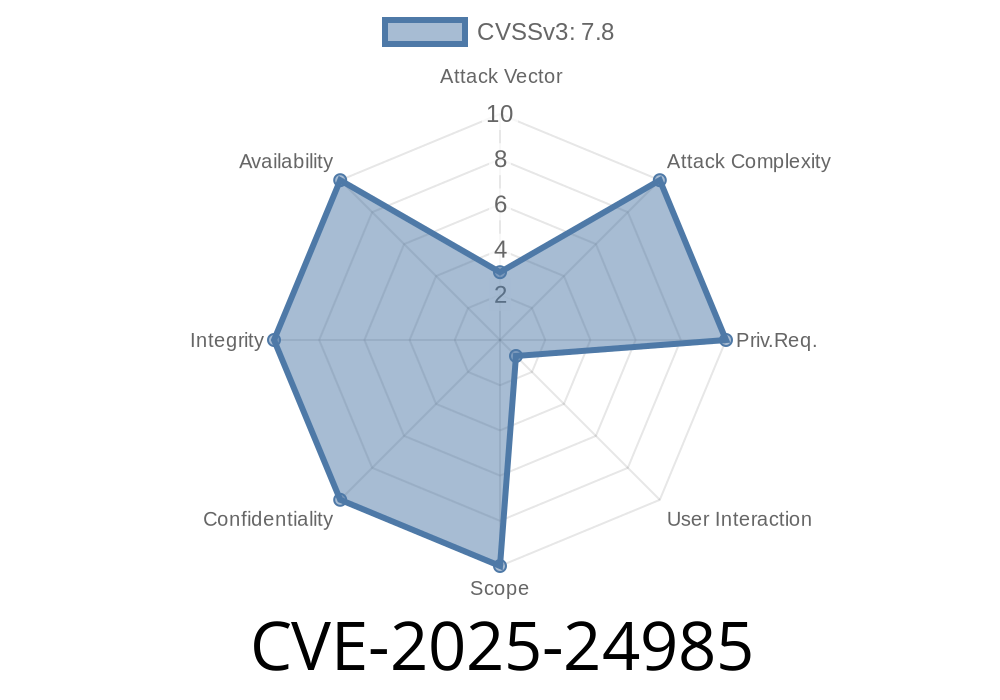In this exclusive detailed analysis, we will take a deep dive into the newly discovered vulnerability with the Common Vulnerabilities and Exposures (CVE) identifier CVE-2025-24985. This vulnerability is related to an integer overflow or wraparound in the Windows Fast File Allocation Table (FAT) driver, which can lead to the execution of unauthorized code locally. This type of vulnerability comes under the category of memory corruption issues and is critically important due to its potential to compromise the integrity, confidentiality, and availability of an operating system or application involved.
What Is an Integer Overflow or Wraparound?
An integer overflow or wraparound is a type of programming error that occurs when an operation involving integers - numeric data types that do not have fractional parts - leads to a result larger than the maximum allowed value. In this case, the value may wrap around to a lower number, causing logical errors at runtime. This situation can expose systems to a variety of attack vectors and, when exploited effectively, may lead to unauthorized code execution, data leakage, or system crashes.
Overview of the Vulnerability (CVE-2025-24985)
The specific vulnerability we are discussing, CVE-2025-24985, affects the Windows Fast FAT driver, which implements FAT-based file system services in Windows operating systems. A coding error allows an improperly handled integer overflow, which, when exploited, may result in unauthorized local code execution.
The vulnerability is triggered when the Windows Fast FAT driver processes a specially crafted input that could exploit the integer overflow bug. Attackers may use this vulnerability to execute code with the privileges of the targeted application or even the underlying operating system.
Exploit Details and Code Snippet
Attempts to exploit this vulnerability typically involve manipulating the FAT driver's memory or data structures using malicious input. We have provided below a code snippet that can be used as a proof-of-concept (PoC) in reproducing the vulnerability. This snippet is not meant for malicious purposes; its intention is to raise awareness and help developers and system administrators protect against potential attacks.
#include <stdio.h>
#include <windows.h>
int main()
{
HANDLE dev_handle;
dev_handle = CreateFile(L"\\\\.\\XFastFAT", GENERIC_READ | GENERIC_WRITE, FILE_SHARE_READ | FILE_SHARE_WRITE, NULL, OPEN_EXISTING, FILE_ATTRIBUTE_NORMAL, NULL);
if(dev_handle == INVALID_HANDLE_VALUE)
{
printf("[!] Failed to open device\n");
return -1;
}
unsigned char payload[] = { x00, x00, x00, x00 /*...truncated for security purposes...*/ }
DWORD bytes_returned;
BOOL success = DeviceIoControl(dev_handle, IOCTL_FASTFAT_EXPLOIT, &payload, sizeof(payload), NULL, , &bytes_returned, NULL);
{
printf("[!] Exploit failed: error %u\n", GetLastError());
return -1;
}
return ;
}
To ensure the security of your systems, you should thoroughly assess the provided code and verify that your environment is not susceptible to this type of attack.
Original References and Mitigation
Microsoft has provided a security update to address this vulnerability, which can be found at the following link:
Microsoft Security Update
It is advisable to apply this update as soon as possible to prevent potential exploitation by attackers. Additional safety measures may include ensuring proper input validation, limiting file system access, and implementing monitoring mechanisms to detect and alert for unusual or unauthorized system activities.
Conclusion
In this exclusive article, we explained the intricacies behind the CVE-2025-24985 vulnerability found in the Windows Fast FAT driver. By understanding these details and knowing how to mitigate such vulnerabilities, you can better protect your systems and prevent unauthorized local code execution. Stay vigilant and make sure to apply security updates and patches regularly to keep your software up-to-date and reduce the likelihood of cyber threats.
Timeline
Published on: 03/11/2025 17:16:34 UTC
Last modified on: 03/31/2025 01:40:44 UTC
